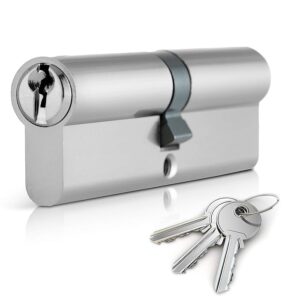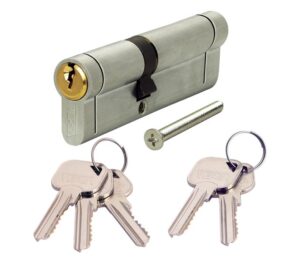As a lock manufacturer, understanding the intricacies of lock cylinder design is essential for creating products that provide both robust security and lasting durability. The lock cylinder—often referred to as the heart of a lock—plays a central role in a lock’s effectiveness and resistance to tampering techniques like lock picking, drilling, and bumping. This blog will delve into recent advancements in lock cylinder technology, design variations, and materials used to enhance the security, functionality, and durability of modern locks.
The Importance of Cylinder Design in Lock Security
A lock cylinder’s design determines its overall security strength, and selecting the right design helps address various security challenges. Traditional pin-tumbler mechanisms remain widely used due to their reliability and ease of rekeying, but with an increase in sophisticated break-in techniques, manufacturers have innovated lock cylinder designs to enhance protection. Key advancements include:
Anti-Bump Technology: Bumping is a method where a special key is used to manipulate the pins and open the lock without visible damage. To prevent this, advanced cylinders incorporate anti-bump pins, which are designed to “catch” if an attempt is made to bump the lock. Some models even use dual-row pin-tumbler systems to make bumping nearly impossible.

Anti-Pick Features: Lock picking involves manually manipulating pins or other locking elements to unlock a door. Cylinders with mushroom or spool pins increase resistance by creating false feedback when a picking attempt is detected, making it more challenging for unauthorized users to align the pins correctly.
Drill Resistance: Hardened steel or carbide inserts are used to make cylinders resistant to drilling attacks. By placing these inserts around critical areas—such as the pins and shear line—the cylinder becomes significantly harder to breach.
Materials Matter: Choosing the Right Metals for Lock Cylinders
The choice of materials for lock cylinders is another crucial factor in determining security, durability, and environmental resilience. Here are some popular materials used in modern lock cylinder construction:
Brass: Widely used for its corrosion resistance, workability, and affordability, brass remains a standard material for lock cylinders. It performs well in most environments, making it ideal for indoor and moderate-weather applications.
Hardened Steel: Steel cylinders are preferred for higher-security applications due to their strength and resistance to tampering. Hardened steel, in particular, is durable enough to withstand drilling and sawing attempts, often seen in commercial-grade locks.
Stainless Steel: For lock applications exposed to extreme weather or corrosive environments, stainless steel provides both durability and rust resistance. It’s often used in marine applications or in locks installed in humid or coastal areas.
Nickel Silver: Used primarily for its wear resistance, nickel silver is often employed in pin construction to ensure smooth operation over time, particularly in high-traffic lock installations.
Types of Lock Cylinders and Their Advantages
Understanding the various cylinder designs helps manufacturers cater to different customer needs and application requirements. Here are a few key types:
Single Cylinder: This traditional design allows key access only from one side and is commonly used in residential applications. It’s ideal for areas where keyed entry is only required on the exterior.
Double Cylinder: A double cylinder lock requires a key on both sides, enhancing security by preventing easy lock access from the inside. This is beneficial for doors with glass panels, where an intruder could otherwise break the glass and open the door.
Euro Cylinder: Commonly used in Europe and increasingly popular elsewhere, Euro cylinders offer an interchangeable core design, making rekeying and cylinder replacement easy. Their modularity allows lock manufacturers to create customizable lock systems with different lengths and security features.
IC Core (Interchangeable Core): These locks are designed with a removable core, allowing for quick rekeying without full lock replacement. This is particularly useful in commercial settings where security requirements change frequently.
Advanced Security Innovations in Lock Cylinder Design
With technology advancing rapidly, lock cylinder design has also evolved to incorporate electronic and biometric enhancements, which provide a higher level of security and convenience:
Smart Key Control: By integrating electronic key control, these systems prevent unauthorized key duplication, reducing the risk of unauthorized entry. Keys and locks are programmed with unique codes, making them only compatible with each other and adding an additional layer of security.
Biometric Integration: Some advanced cylinders now come with fingerprint scanning and other biometric features, which eliminate the need for traditional keys altogether. While still a premium feature, biometric locks offer a unique security advantage in high-security environments.
Keyed-Alike and Master Key Systems: For large facilities with multiple access levels, keyed-alike and master key systems allow for versatile access control. In a master key system, for instance, a “grand master key” can open multiple cylinders with individual keys for each user, which simplifies management and reduces key clutter.
Best Practices for Choosing the Right Cylinder for Different Applications
For lock manufacturers and clients alike, selecting the right cylinder is essential for balancing cost, security, and ease of use. Here are some considerations for choosing the most appropriate cylinder for each application:

Determine Security Needs: Residential locks generally don’t require the same level of security as commercial or high-security installations. Higher-grade cylinders with advanced tamper resistance, such as drill-resistant cylinders, are more suitable for business or industrial applications.
Assess Environmental Conditions: Outdoor locks should be corrosion-resistant and capable of withstanding weather exposure, while indoor locks may prioritize ease of use and rekeying capabilities.
Consider User Accessibility: For settings with multiple users, locks with easy rekeying, like interchangeable core cylinders, provide convenience and flexibility. Likewise, electronic or smart locks may appeal to clients seeking a keyless, high-tech solution for greater accessibility.
Conclusion
The evolution of lock cylinder design has introduced innovative solutions that increase tamper resistance, improve material durability, and cater to a variety of access control needs. By selecting the right cylinder type and material, lock manufacturers can enhance security and usability across different applications. Whether for residential, commercial, or high-security environments, modern lock cylinder technology offers solutions to meet the demands of today’s diverse security landscape.
